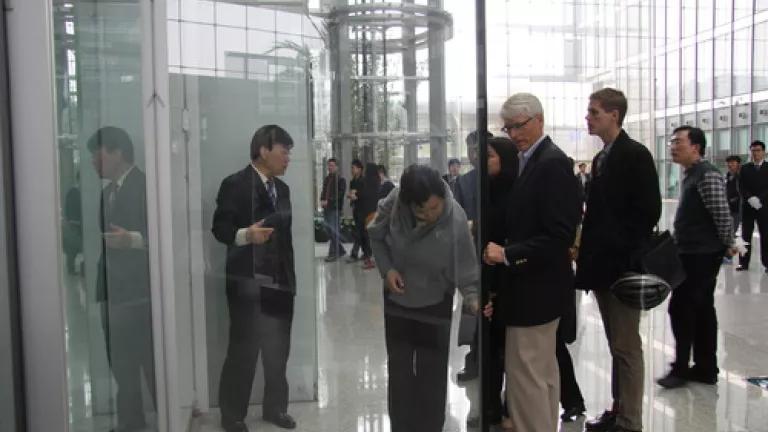Why Benchmarking Is Critical for Saving Energy in China
Over two-thirds of existing buildings in China are energy inefficient; this energy consumption accounts for about one-fourth of the country’s total CO2 emissions. Fortunately, Shanghai’s Changning District is now focusing on tackling this issue: China’s first building energy efficiency benchmarking policy was passed by Changning District early this year.

The Shanghai World Bank Low-Carbon City Project Presentation Forum
This is a guest post by Zhiming Pan.
Over two-thirds of existing buildings in China are energy inefficient; this energy consumption accounts for about one-fourth of the country’s total CO2 emissions. Large buildings have particularly high energy intensities. In Changning District, located in downtown Shanghai, large buildings only take up 64 percent of floor space but account for over 90 percent of energy consumption in the building sector. Fortunately, Shanghai’s Changning District is now focusing on tackling this issue: China’s first building energy efficiency benchmarking policy was passed by Changning District early this year.
NRDC has been deeply involved with Changning’s building energy benchmarking policy development. NRDC introduced building energy benchmarking to Changning and provided years of support through study tours, expert workshops, feasibility studies, stakeholder outreach and technical consultancy. Lessons from these collaborative efforts helped steer Changning District’s benchmarking policy toward one that standardizes evaluation, promotes information disclosure, and provides a user-friendly system.Over two-thirds of existing buildings in China are energy inefficient; this energy consumption accounts for about one-fourth of the country’s total CO2 emissions. Large buildings have particularly high energy intensities. In Changning District, located in downtown Shanghai, large buildings only take up 64 percent of floor space but account for over 90 percent of energy consumption in the building sector. Fortunately, Shanghai’s Changning District is now focusing on tackling this issue: China’s first building energy efficiency benchmarking policy was passed by Changning District early this year.
Shanghai’s Changning District is staying true to its commitment. At a recent forum, the district government presented the Shanghai Low-Carbon City Project, an initiative supported by the World Bank (WB), which prioritized addressing energy inefficiency in large existing buildings, and highlighted the building energy efficiency benchmarking policy as a critical project deliverable.
The Shanghai Low-Carbon City Project is an interesting example of Shanghai’s growing interest in energy efficiency benchmarking. Under the larger goal of advancing low-carbon urban development in Shanghai, the project aimed to help the city renovate its existing large buildings by piloting green energy methods, with Changning District as a key pilot. These efforts led to the issuance of the benchmarking policy, which is expected to produce enough energy savings to power 300,000 households (more than the current 258,700 households in the Changning district).
One of the challenges faced by Changning District was how to motivate building owners to act. Building owners did not seem to be active enough, even when the World Bank project made low-interest loans available. Before the project was launched, experts had thought that financing was the major barrier, since retrofitting these buildings demands more investment than the district government budget could afford.
In these situations, building energy benchmarking policies comes in handy because they bring to bear peer pressure and non-monetary incentives, such as upholding the reputability of corporations that perform well in energy use. By collecting and analyzing energy bills and comparing annual energy use among similar buildings, benchmarking offers comprehensive and easy-to-access information that shows building stakeholders where their buildings stand in terms of energy performance. Similar policies in New York City, Washington, D.C and San Francisco have already seen 2-3 percent energy savings over the past few years.

Laurie Kerr, Director of Policy at the Urban Green Council, and Zhiming Pan, Director of NRDC China Sustainable Cities Project meets with the Changning team in February 2017 to discuss building policy frameworks and strategies.
Ying Chen
“Compared with monetary gains, building owners care more about their Corporate Social Responsibility image and company reputation. The benchmarking information allows us to realign our policies and incentive programs to create energy efficiency retrofit demand from building owners.”
—Qin Mao, Director of the Urban Renaissance and Low Carbon Development Office of Changning
According to Changning District’s new benchmarking policy, large buildings exceeding 20,000 square meters (215,278 ft2) of floor space will be ranked on a yearly basis based on their energy consumption alongside other buildings of similar function. For each year’s ranking/benchmarking, a third party will verify the data reported by building owners and calculate rankings based on last year’s energy consumption. Rankings will then be disclosed to local owners, managers, and investors who can utilize this information to push for buildings’ energy efficiency enhancement accordingly.
Cheers to Changning District for implementing a great new benchmarking policy. We at NRDC are happy to have played a small part in its success!


